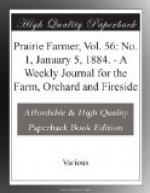The thoughts I have presented are intended to be suggestive rather than dogmatic, and I leave the subject with the hope that the intelligence of the average dairyman may be as active in tracing and comprehending the subtler principles of trade and commerce relating to the products of his labor as he is in comprehending the more immediate facts of his calling, such as breeding, seeding, and the handling of the raw products of his herd.
[A] Paper read before the Illinois Dairymen’s Convention by C.C. Buell, of Rock Falls.
VETERINARY.
FEVER.
Many kinds of horse fevers have been described by antiquated veterinary writers; but most exist only in the imagination of the writers, or have been manufactured out of the mistaken analysis of human fevers. All the real fevers of the horse may be comprised in two,—the idiopathic, pure or simple fever, constituting of itself an entire disease, and the symptomatic fever, occasioned by inflammatory action in some particular part of the body, and constituting rather the attendant of a disease than the disease itself.
Though idiopathic fever is comparatively infrequent in occurrence, it unquestionably meets the attention of most persons who have extensive stable management of horses, and its general tendency to degenerate into local inflammation and symptomatic fever, seems to arise far less from its own nature than from foul air, vicissitudes of temperature, and general bad management. If idiopathic fever is not easily reduced, the blood accumulates in the lungs, the viscera, or some other internal part of the body, and provokes inflammation; or, if a horse, while suffering under this fever, be kept in a foul or ill-ventilated stable, or be exposed to alternations of heat and cold, he speedily becomes locally inflamed from the action of the filth or exposure. The symptoms of idiopathic fever are shivering, loss of appetite, dejected appearance, quick pulse, hot mouth, and some degree of debility; generally, also, costiveness and scantiness of urine; sometimes, likewise, quickness of breathing, and such pains of the bowels as accompany colic. Idiopathic fever, if it does not pass into inflammation, never kills, but is generally always curable.
Cattle are subject to both idiopathic and symptomatic fever, very nearly in the same manner as the horse, and require, when suffering them, to be very similarly treated. The idiopathic fever of cattle has, in many instances, an intermitting character, which may easily be subdued by means of ordinary care; and, in other instances, has a steady and unintermitting character, and is exceedingly liable to resolve itself into pleurisy, enteritis, or some other inflammatory disease. The symptomatic fever of cattle is strictly parallel to the symptomatic fever of horses, and is determined by the particular seat and nature of the exciting inflammation. But besides these fevers,




